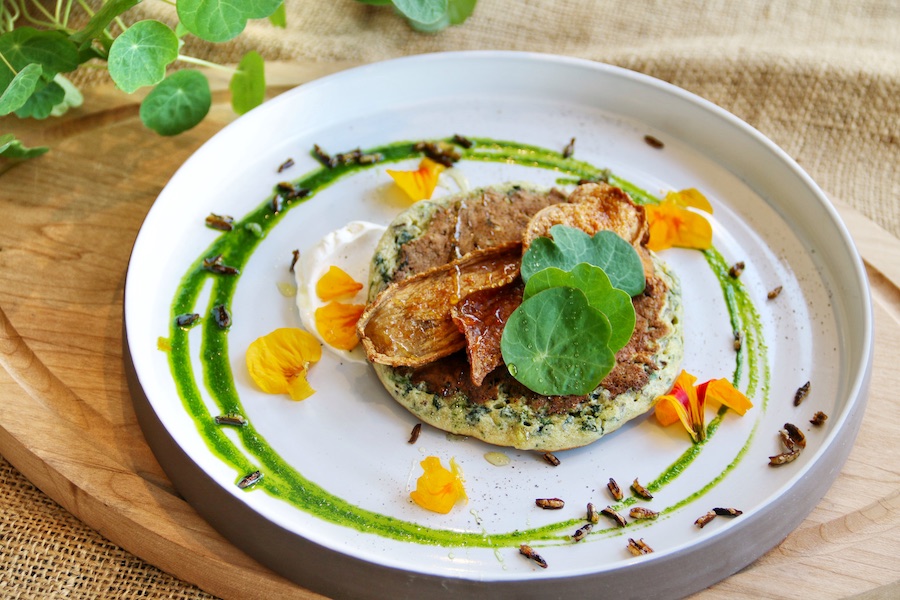The nasturtium plant is closely related to cruciferous aquatic plants like watercress. Nasturtium leaves and nasturtium stems share similar flavor profiles – peppery, spicy and grassy, while nasturtium’s delicate yellow, orange and red blossoms can add floral notes and sparkle to the plate.
Growing Nasturtium
According to our hydroponic garden manager, Caleb Raff, nasturtiums grow easily indoors and outside. But, according to Caleb, “hydroponics are significantly faster, both in terms of how long germination takes and the actual rate of growth.” Caleb grew nasturtium microgreens and full shoots for the recipe below in just a couple of weeks.
If you don’t have a garden to forage from, you can pick nasturtium in the wild. Always be sure to check that the location isn’t sprayed with chemicals you wouldn’t want to eat. Otherwise, you can purchase nasturtium leaves and flowers at farmers markets in mild and warmer seasons, at specialty grocery stores or online.
Nasturtium Nutrition
From the Americas to the Middle East, various species of the plant – from root to flower bud – have been used as staple foods, and therapeutically, wherever it grows. Just like any edible leafy greens, nasturtiums are rich in fiber, folate and antioxidant vitamins A and C, all of which contribute to maintaining healthy cells and help reduce the effects of oxidative damage that can lead to cardiovascular disease.
Caution: In addition to the leafy and flowery parts, young buds can be brined like capers. But, unlike caper berries, nasturtium buds contain high levels of oxalic acids, which lock in other minerals in foods so that they cannot be digested. If, for example, calcium is present in a food, compounds are formed that can increase your risk of kidney stones.
Edible Leaves and Flowers
Try tossing washed nasturtium leaves and flowers into salad greens or wilting them into risotto or soups. Handfuls can be pureed with basil, garlic and a hefty glug of extra virgin olive oil for pesto with a peppery bite or to smear onto your next sandwich or homemade pizza.
Nasturtium Recipe
This savory wild rice nasturtium pancake recipe, adapted from the Health-Supportive Culinary Arts curriculum, plays on the flavors, growing conditions and history of the plant. Spicy and grassy leaves from our on-site farm are folded into whole-grain batter accented by earthy wild rice. Fresh nasturtium petals, a smear of cultured cream, drizzled honey, mushroom “bacon," and wild rice crispies complete the story. While the recipe below is vegetarian, it can be easily veganized. Try swapping out the milk for your favorite nut variety and whipping aquafaba into peaks in place of egg whites.


Ingredients
- 1 cup organic whole milk
- 2 tablespoons lemon juice (about ½ lemon)
- 2 tablespoons neutral-flavored oil
- 1 cup whole wheat pastry flour
- 1/2 teaspoon aluminum-free baking powder
- 1/2 teaspoon baking soda
- 1/2 teaspoon sea salt
- 4 ounces nasturtium leaves, blanched, shocked, roughly chopped
- 1 cup fully cooked wild rice (from 1/3 cup raw rice), roughly chopped
- 3 large pastured egg whites, beaten to soft peaks
- 1 cup cultured cream
Garnishes: - 1/4 cup honey or grade A maple syrup
- 1/2 ounce nasturtium shoots with leaves and stems
- 1/2 ounce nasturtium flowers
- 1/4 cup nasturtium infused oil
- 10 pieces mushroom “bacon” (thinly sliced oyster mushrooms roasted until crispy on both sides - about 10 minutes at 350 F)
- 1/4 cup wild rice crispies (wild rice cooked, dried in 235 F oven and deep fried at 385 F)*
Directions
- Whisk together milk and lemon juice. Let stand 15 minutes. Add oil.
- In a separate bowl, whisk together flour, baking powder and soda, and salt. Add rice.
- Gradually add milk to dry ingredients and stir to combine. Add nasturtium and fold in egg whites.
- Heat a large non-stick pan over medium heat.
- Using a ladle, pour batter onto pan leaving about 1 inch between cakes for easy flipping. Cook cakes until bubbles in batter break on surface; flip and cook until browned.
- Serve with garnishes to taste.
*One of the things I love most about ICE is the caliber of colleagues I get to work alongside. A casual conversation with my office mate, Chef Barry Tonkinson, our director of culinary research and development, got us both thinking about crispy wild rice garnishes. Two weeks later, he turned up with an at-home version that’s hard to resist.
Study plant-based cooking with Chef Celine at the Natural Gourmet Center.




